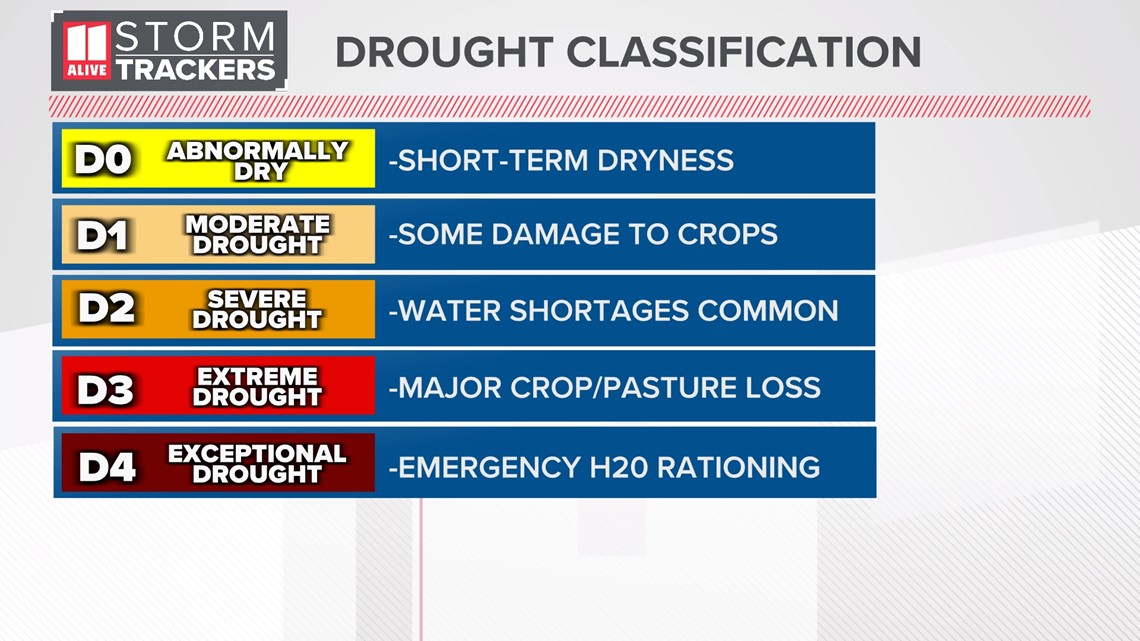SUMMERVILLE, Ga. — Drought is expanding in parts of North Georgia - and it's likely going to get worse before it will get better.
There is now a Level 3 'Extreme' drought in the state for the first time in four years. During these extreme drought conditions, impacts surpass a lack of topsoil moisture. It can have a significant impact in the agriculture industry.
The epicenter of the state's drought centers in northwest Georgia are Dade, Walker, Catoosa, and Chattooga counties.
According to Georgia's State Climatologist Bill Murphey, many of these areas picked up less than an inch of rain since Sept. 1. A local CoCoRaHS weather station in Ringgold has been the driest, with just 0.57" of rain in the last 7 weeks. Parts of Pickens and Bartow counties fall just behind that with receiving 0.9" since the start of meteorological fall.
The impacts in northwest Georgia are getting more significant.
"Over the last 90 days, there's been a noticeable decline in soil moisture," said Murphey.
He added that the weather pattern of high-pressure-induced sunny days has only worsened the impacts.
"Not only have we seen a rain deficit growing, there's been dry air and low humidity levels over the area," he said. "This creates more evapotranspiration that sucks the moisture out of the ground."


Murphey said the northwest corner of the state is even seeing this current drought starting to impact pond levels and stream flows, which usually lag behind soil impacts.
Drought creates stress on Georgia's agriculture industry
Murphey said that the lack of moisture is now creating significant agricultural impacts in the state's northwest corner.
"Pastures have gone dry. Farmers are having to supplement and feed hay to cattle," Murphey explained.
Murphey said his office frequently receives feedback from local farmers nationwide through an online form. According to one Walker County farmer who reported the worsening conditions this week, this is the worst they've seen since 2016. They have to feed the cattle hay, a process that usually doesn't start until Christmas. They said things are getting so bad, that they're selling calves early to take stress off the mother cows. And it's impacting the bottom-line prices.
"Now calf prices have dropped 20 cents per pound and cow prices are down by 1/3rd," the farmer added.
The impacts on the agricultural industry are felt in each county in northwest Georgia. Rebecca Thomas, Chattooga County extension coordinator, said that local farmers "are having to adapt," just like they would with any extreme patterns of heat or drought. In Chattooga County alone, this is its first "extreme drought" in more than six years, since early 2017.
Dr. Pam Knox, Director of the UGA Weather Network and Agricultural Climatologist, said outside the impact to the cattle industry, it's also playing a huge role in delaying of winter grains. "The planting of wheat and rye are delayed. Farmers planted seeds, but without rain it can't germinate. They need those to get established before our first frost and freeze of the season occurs. We're running out of time for that, unfortunately," eluding to the colder air incoming for the start of November. The wheat and rye are used to feed cattle as well. Luckily, Knox said this is not playing a large impacts on the chicken industry as much.
What about metro Atlanta?
People see "abnormally dry" conditions in much of the inner metro. Level 1 "Moderate drought" is present in parts of Gwinnett, Cherokee, and Bartow counties and in eastern Georgia near Athens. Topsoil conditions are dry. Atlanta has picked up 1.78" this October, a little below an inch below average. For the entire meteorological fall since Sept. 1, there has been a running rain deficit of nearly 3 and a half inches.


So when will things get better?
Murphey said conditions do not look optimistic through the first days of November.
"We may see the drought expanding before we can cut away at its extensiveness. Things look to stay mostly dry for the next 1 to 2 weeks," Murphey said.
It's possible Georgia could see the Level 3 'Extreme' drought expanding next week without any guaranteed rain in the forecast for the next 7 days.
The developing drought is only expected to be a short-term obstacle.
With the presence of an El Niño this winter, the southern jet stream should help create wetter-than-normal conditions throughout the winter months.
Is drought impacting this year's peak of fall foliage?
During extreme drought conditions, premature leaf drop can happen. According to the Georgia Forestry Commission's report for this week, in northwest Georgia, it has not yet played a significant impact on northwest Georgia foliage.
The U.S. Drought Monitor is released each Thursday morning, showing where drought is and how bad it is. The map uses six classifications: normal conditions, abnormally dry (D0), showing areas that may be going into or are coming out of drought, and four levels of drought: moderate (D1), severe (D2), extreme (D3) and exceptional (D4). Hundreds of observers, including climatologists, meteorologists, agricultural scientists, hydrologists, and others, correspond to create each week's drought monitor.



